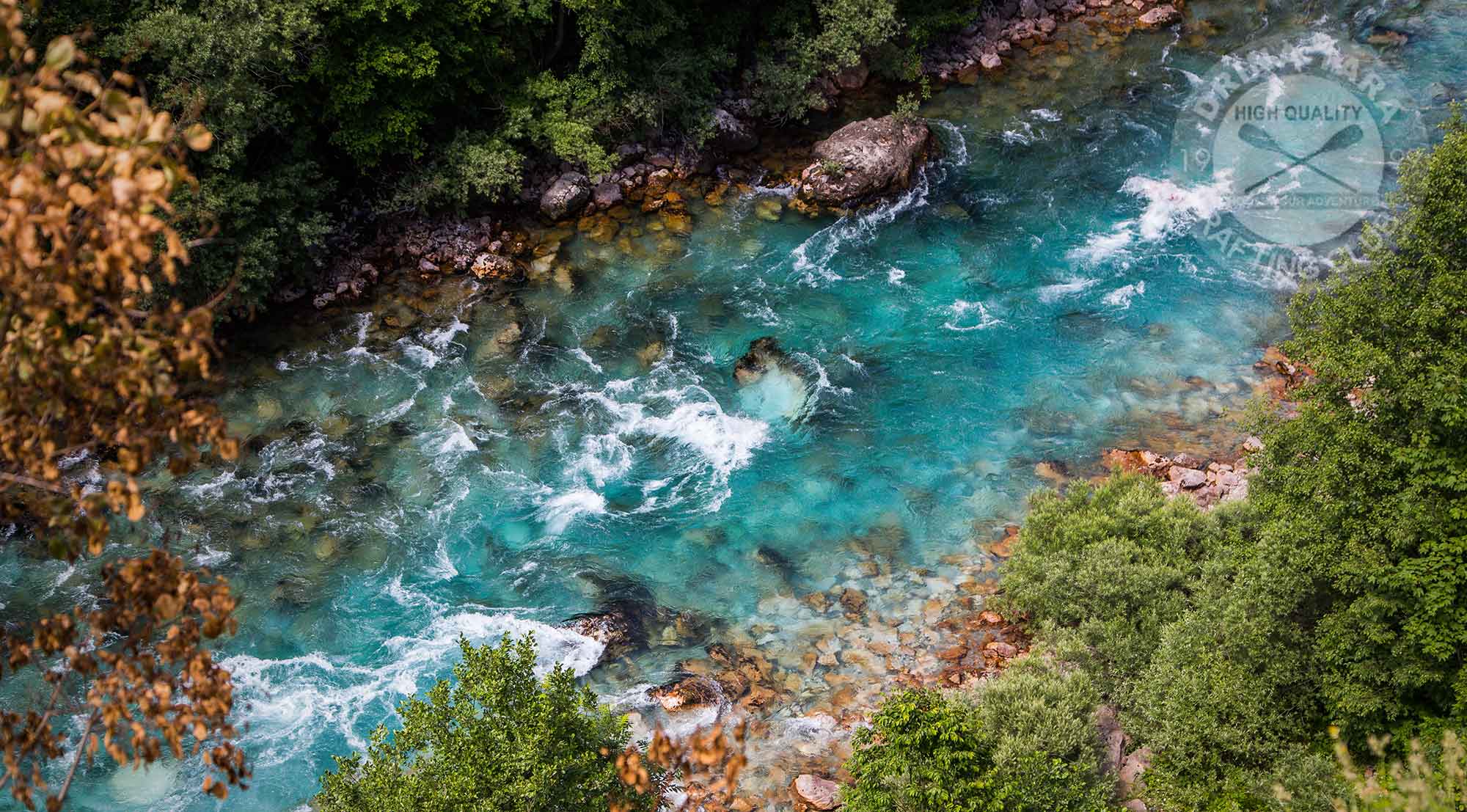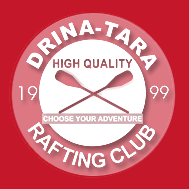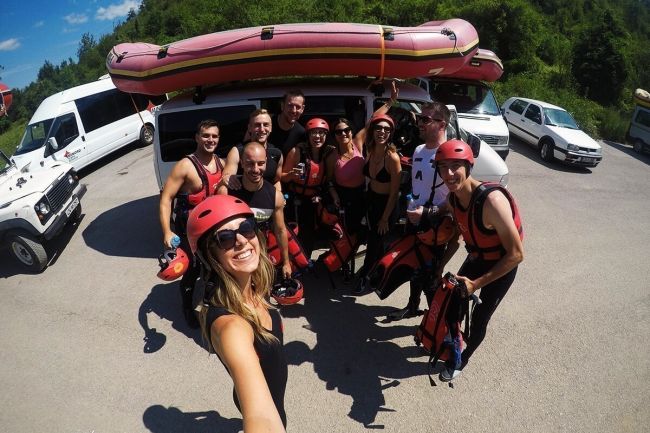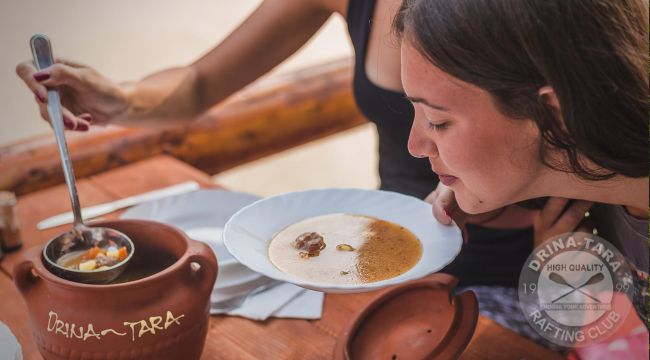
The Tara River - the tear of Europe, is a unique wonder. Concealing numerous springs and tributaries, rapids, caves, and waterfalls, it has carved through the mountains, flowing through the abysses of the canyons, clear and magical. Tara and Drina attract not only rafting enthusiasts, nature lovers, walkers, and hikers but these two mountain rivers and the emerald lakes in their surroundings represent a true treasure for all those engaged in sport fishing. Considering that guests of the "Rafting Center Drina Tara" camp often inquire about fishing tours, we have created a small guide on fishing in the canyons of Tara and Drina, as well as on nearby lakes.
In the following lines, you will learn more about the fish species present in these crystal-clear waters, as well as the favorite techniques among fishermen. We have inquired for you about how to obtain the necessary permits and their prices. Do you dream of fishing in Lake Trnovačko or the fast-flowing mountain rivers that form the natural border between Bosnia and Herzegovina and Montenegro? If you fantasize about catching trout and other fish species abundant in the Drina and Tara rivers and plan to spend days with friends in these magical rivers and clean air, enjoying relaxation, fun, adrenaline, and excitement, we will guide you on a fishing adventure.
Which fish species can be caught in this area?
In the rivers Tara and Drina, the most commonly caught fish species are salmonids, including brown trout, grayling, and brook trout. Among the cyprinid species, the most abundant in the Drina is the vimba bream (also known as vimba or vimba vimba). All lakes located within the municipality of Foča belong to the Sutjeska National Park, and they are inhabited by salmonid fish species such as brown trout and grayling.
The brown trout (Salmo trutta - morpha fario) is a predator with an elongated body and sharp teeth. It has distinct red or black spots on its body. It usually hides under tree roots, among rocks, or in hollowed parts of the shore, in deep pools. It ventures into shallow areas and rapids primarily in the evening, searching for insects on the water's surface. The favorite food of brown trout includes insects and water larvae, as well as smaller fish.
The grayling (Thymallus thymallus) prefers cold, oxygen-rich waters, which is why it has found its habitat in our region. Its body is spindle-shaped, elongated, and covered with relatively small scales deeply embedded in the skin. The grayling has a very elongated dorsal fin of metallic blue color. It moves in smaller schools and primarily stays in the upper reaches of the river.
The huchen (Hucho hucho), also known as the Danube salmon, is a freshwater fish from the trout family known for its swift movement through the water. It feeds on fish and crustaceans, and in the morning hours, it dwells around the entrances to whirlpools, while in the evening, it moves towards their exits after feeding, returning to its hiding place. Fishing for huchen in the Tara River is particularly attractive due to the rarity of this species.
The nase (Chondrostoma nasus) - moves in large schools and feeds on algae and silt scraped from coarse gravel. It has found its habitat in fast waters, which it shares with barbel, chub, and bleak. This fish feeds from the bottom, and experienced anglers know that nase should be sought in deep, calm pools next to rapids and that the best bait is a mixture called "primama" based on bread and other additives. It spawns from March to May, so there is a fishing ban during that period.
The brook trout (Salvelinus fontinalis) lives in cold streams and rivers with oxygen-rich water, and it is also found in small and medium-sized lakes. It is recognized by the light spots on its dark skin surface.
Which fishing technique is preferred for each fish species?
Fishing on the Tara River is allowed exclusively with artificial bait. The preferred techniques on the Tara and Drina rivers are lure fishing (using artificial lures from the shore) and fly fishing for salmonid fish species, while cyprinid species such as vimba bream are often caught using float fishing.
Lure fishing is a fishing method that involves using artificial lures to deceive and provoke predatory fish into "striking." Lure fishing is different from other techniques in that it is mobile, requiring anglers to change locations in search of fish and enticing them to attack the artificial lure.

Fly fishing is a special technique that requires skill and looks very attractive. In this fishing method, a lightweight lure resembling a fly is used. The artificial fly is cast using a fly rod in a way that mimics an insect landing on the water. This is achieved with the help of a reel, fly line, leader, and a special casting technique.
Float fishing, also known as fishing with a float, is commonly practiced on fast-flowing rivers, especially when targeting Vimba bream. Subtypes of this technique include stop float fishing (aiming to have the bait move slower than the water flow by precisely measuring the depth of the terrain) and trotting (the distance between the float and the hook corresponds to the actual water depth - with the tip of the rod, we keep the line constantly taut, slightly slowing down the float to prevent it from being carried away uncontrollably by the fast currents).
How can one obtain a fishing permit?
All permits issued for fishing on the Tara and Drina rivers are for recreational fishing and can be obtained at the office of the Sports Fishing Association "Mladica" in Foča or from fisheries guards.
The types of permits are as follows:
- Daily permit (valid for 1 day from 00:00 to 24:00) for cyprinid fishing species is 10.00 KM, while for fishing salmonid species it is 20.00 KM.
- A weekly permit (valid for 7 days) costs 40 KM for fishing cyprinid species and 50 KM for salmonid species.
- A monthly permit (valid for 1 month) requires a fee of 60 KM for fishing cyprinid species while fishing for salmonid species for a month costs 70 KM.
- The price of a seasonal permit is 135 KM, and it is valid for 6 months.
All the aforementioned types of fishing permits for recreational fishing are valid only in the fishing area of the Foča Municipality managed by the Sports Fishing Association "Mladica" Foča, and they are issued to citizens of Bosnia and Herzegovina who do not have a residence permit (ID card) issued by the Foča Ministry of the Interior, as well as to foreign citizens.
It should also be emphasized that there are annual permits available for individuals with a residence in the Foča Municipality. The prices for these permits are as follows:
- For recreational anglers between the ages of 18 and 65, the permit fee is 90.00 KM with an additional 8.00 KM for the membership card.
- Recreational anglers between the ages of 14 and 18, over 65, and women between the ages of 18 and 65, the permit fee is 45.00 KM, with an additional 8.00 KM for the membership card.
- For members of associations, i.e., recreational anglers who are disabled (categories I to IV) or parents of fallen soldiers of the Army of Republika Srpska, the permit fee is 45.00 KM, plus an additional 8.00 KM for the membership card.
It should be further emphasized that recreational anglers under the age of 14 can engage in fishing without a permit only in the presence of an adult with a valid permit.
When is fishing prohibited in the rivers Tara and Drina?
The period of prohibition refers to the closed fishing season. During this time, fish may not be caught, retained, transported, unloaded, transshipped, or stored. Additionally, it is not allowed to exhibit, process, sell, or trade fish during this period. Here are the closed fishing seasons for the following fish species:
- Brown Trout: from October 1st to March 1st
- Grayling: from March 1st to May 31st
- Huchen: from February 1st to August 31st
- Nase: from April 1st to May 31st
- Chub: from April 15th to May 31st
- Roach: from April 15th to May 31st
- Barbel: from May 1st to July 31st
Can visitors get a guide?
Visitors, sports anglers, can get a guide, primarily in the form of a fish warden and volunteer fish wardens, as well as someone from the society's members.
Fishing equipment cannot be rented on-site, so it is necessary to bring all the necessary gear and accessories. For fishing for grayling and trout, a 9ft rod (2.74m) with a #5 weight rating is recommended, with a medium action (meaning it flexes from the middle of the rod). Reel, WF, and DT fly lines, backing, leader, and tippet are some of the essential components of fly fishing gear that will enable you to achieve the best results in this exciting form of sport fishing.
On which lakes are fishing allowed?
There are as many as eight lakes near our campsite! The lakes located within the municipality of Foča belong to the Sutjeska National Park, and all information regarding fishing on these lakes can be obtained directly from the national park. You can reach them at the following address: Dolina Heroja, 73311 Tjentište, Bosnia and Herzegovina, by sending an email to: office@sutjeskanp.com, or by calling the phone number: +38758233130

Immerse yourself in the charms of fishing in the deepest canyon in Europe, on the water so pure that it can drink, in a green environment that rejuvenates the soul and body. If you're intrigued by the thrill of battling the fish of the Tara and Drina rivers with lures, flies, or floats, book your stay at our camp, and we'll ensure that your fishing adventure on the rivers Tara and Drina remains a lasting memory. Cheers!








